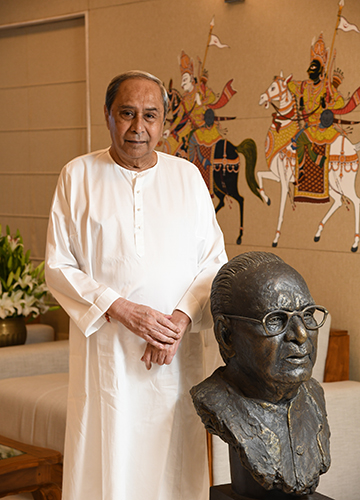ELECTIONS IN ODISHA may be more than a year away, but the Biju Janata Dal is an early riser. The party has been in power since March 2000 and is raring to win the assembly and Lok Sabha polls again in mid-2024.
The confidence was on display as 50,000 office bearers assembled in Puri on December 26 for a grand celebration of the party’s silver jubilee. The choice of the temple town as the venue added religious fervour to the event. After all, the BJP with its hindutva edge is its main rival in both elections. The BJD has drawn up a yearlong programme in all constituencies with an eye on elections.
The BJD’s main strength is the popularity of Chief Minister Naveen Patnaik. He was a reclusive writer based in Delhi when the Janata Dal made him its candidate for byelection to the Aska Lok Sabha seat on the death of his father, the legendary Biju Patnaik, in 1997. He won, but left the Janata Dal and founded the BJD the same year.
The founding of the BJD was perhaps a political necessity to decimate the Congress. Foreseeing the rise of A.B. Vajpayee and the BJP, certain Janata Dal leaders in Odisha wanted to be on their side. The BJP, on its part, guessed that Patnaik would inherit his father’s political influence. So, in a symbiotic relationship, the two parties formed an alliance and won the Lok Sabha elections in both 1998 and 1999.
Patnaik became cabinet minister under Vajpayee but shifted base to Odisha for the assembly elections in 2000, in the wake of the super cyclone of 1999. He led the alliance to a massive victory and became chief minister. Astounding people who thought he was a political innocent who could not even speak Odia, he advanced the next assembly elections by a year, clubbing it with the Lok Sabha polls of 2004, winning them both.
While the BJP lost at the national level, the BJD retained Odisha largely because of the clean image of Patnaik, who had dismissed outright three ministers accused of corruption. He broke up with the BJP before the 2009 Lok Sabha election, after the Sangh Parivar was accused of communal violence in Kandhamal district. Going solo, the BJD won more seats than the alliance had won in the earlier elections.
Since then the BJD has won all elections, fighting both the BJP and the Congress. Only in 2019 did its Lok Sabha tally decline; it won only 12 of 21 seats from Odisha. In the assembly election the BJP became the main opposition party in the state, pushing the Congress to a poor third slot.
After the alliance broke up, the BJD has remained equidistant from the ruling and opposition fronts at the national level. However, it has helped the BJP in passing bills in Parliament and in the election of presidents and vice presidents.
It was with the BJD’s support that Ashwini Vaishnaw, now railway minister, was elected to the Rajya Sabha as a BJP candidate in 2019. It indicated that the two parties were softening towards each other. Nonetheless the BJD scored a massive victory in the last civic elections, sweeping the BJP aside.
Yet, in the recent byelections to the assembly from Dhamnagar in coastal Odisha and Padmapur in western Odisha, the two parties fought hard and retained their seats. For the victory in Padampur, however, the chief minister had to campaign rather vigorously; he has rarely campaigned in byelections to the assembly.
The Patnaik government has done well by promoting economic resurgence in a state known earlier for poverty and underdevelopment. It has raised revenues using the state’s mineral potential and invested them for infrastructure development, education, health and women’s empowerment.
The state’s strategy of involving women in income generation programmes through Mission Shakti has helped the BJD politically. “If mothers bless, the party will remain in power for one hundred years,” said Patnaik at the silver jubilee celebration.
Patnaik also spoke about helping farmers, tribals and weaker sections and about success in handling natural calamities. Though he did not criticise the BJP or other parties, he said Odisha was not getting its due from the Union government.
The BJD came into being when there was a political vacuum and the Patnaik government ensured growth for every sector, said Debiprasad Mishra, its senior vice president and legislator. “Its financial management is one of the best in India,” he told THE WEEK. “It is the only state which is reducing the loan burden, and its GSDP-loan ratio is the lowest. The state is going for massive industrialisation, and investment proposals worth 010.5 lakh crore were received at the recent Make in Odisha conclave in Bhubaneswar.”
Ranendra Pratap Swain, minister for agriculture, fisheries and animal resources development, said the state had achieved big success in agri production. He noted that the state had become the sports capital of India. Odisha has hosted several international events in the past few years, and the Hockey World Cup is starting there in January.
The party, which started its journey with followers of Biju Patnaik, has evolved over the years. Many leaders from other parties have migrated to the BJD and occupied important positions. In the process, many pioneers have left it or have been purged. The party solely depends on the popularity of 76-year-old Patnaik, who has not projected a successor. He has been more mobile than usual after the Covid years. This indicates that he will lead the election campaign in 2024.


